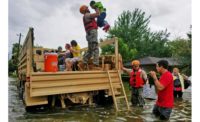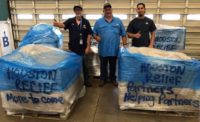I was prepared when my plane started its long final approach into Houston Hobby Airport. I had my camera ready and I twisted myself in my seat to get some good shots of nature’s carnage as we descended into a city recently ravaged by Hurricane Harvey. I was pretty lucky booking this trip just hours before it was supposed to happen. Displaced residents are taking up most of the hotel rooms in town and finding a rental car available was just a matter of pure, dumb luck.
As we descended I could see rural properties under a bright Texas sun, all boasting normal-looking irrigation ponds. The rivers and bayous appeared a little brown, but nothing was overflowing its banks. About the only damage that could be seen from the air on final approach was an eight-field softball complex, all under water to one degree or another.
After a shuttle to the rental car place, I was off directly to visit the folks at Milton Frank Plumbing of Spring, Texas, Reeves Journal’s 2017-2018 Western Contractor of the Year. (Reeves Journal is a sister publication of pme.) General manager Jessica Burden-Frank said I was a week late to see all the water.
“The plumbing work really hasn’t started yet,” she said. “Now it’s mostly HVAC work because lots of air conditioners were under water. We expect the big plumbing work, demolition and the like, to be starting up soon.”
Unlike reports that may have you believing Houston has been leveled, the fact is the damage is concentrated in certain areas, while others got through the storm relatively untouched. Some evidence of the hurricane was visible driving through town — a few closed roads, big piles of waterlogged trash scattered here and there, and a few construction sites looked like they had been roughed up. In affected residential areas, ruined furniture and other junk was stacked along the sides of the streets so remediation could get started.
Staying positive
The next morning I hooked up with Josh Hollub of Modern Plumbing in Pasadena, Texas. He had a call to make in a neighborhood damaged by the floods and another at a huge veterinary hospital probably best known for being the location of NatGeoTV’s “Animal ER” program.
“The big difference between this and [Hurricane] Katrina is those people sat around waiting for help,” Hollub said as we were driving to the first call. “We had a lot of help. There was still water in people’s yards while they were ripping out drywall.”
We turned into a middle-class neighborhood, its streets lined on both sides with ruined possessions and house contents. The residents’ wry sense of humor was evident in the rubble as we drove past. A waterlogged mattress in one pile proclaimed it was in the “Yard of the Month.”
“I don’t like two-story houses,” the homeowner, a longtime customer of Modern Plumbing, said. “So I have a lot more to fix than the people in two-story houses — one floor, 3,000 square feet. We hear now we’re going to have to itemize everything and take pictures. My wife’s going crazy over it but I just say we need to take our time.”
He showed cellphone footage of a Marine Blackhawk helicopter lifting people from a nearby backyard, and another clip of Marines driving their lumbering amphibious assault vehicles down residential streets offering to help people get out at the storm’s height.
This visit was quick. The house had already been emptied and stripped of carpeting and the drywall was cut and removed from the water line down. Hollub made quick work of removing a kitchen sink and replacing a number of water supply valves in the kitchen and a bathroom as part of the general demolition/repair/cleanup work being done.
A locked door
The second stop at the main location of Gulf Coast Veterinary Specialists Hospital in Houston was shocking. The clinic was a longtime client of Modern Plumbing and seeing it lying in ruins wasn’t pleasant for Hollub.
“This is terrible,” he says. “You’ve been working around a place like this for 10 years and this is hard to see.”
It’s a three-story building but the lowest floor is built into a side of a slope leading down to a creek bed. The lowest floor was still flooded, its water reaching up to the second-floor landings. In it floated various items from the submerged floor, including couches, a desk and even a potted plant. The job for Hollub, a medical gas specialist, was to get inside and shut off the medical oxygen and nitrogen so other construction workers could do their work safely. A spark in a pure oxygen environment is a dangerous thing.
The first thing that hits you upon entering the building is the smell. It’s a funky, moldy smell like nothing else on Earth. Masks were required. The interior was mostly pitch dark. Taking a picture was a matter of pointing the camera until it focused on something, releasing the shutter and hoping whatever was revealed by the flash wasn’t going to be an unpleasant surprise.
The floors were covered in rubble from the collapsed ceilings and there was also a layer of greasy brown mud that made walking around in the dark a little treacherous. All the hospitals’ patients had been evacuated before Harvey hit but we caught an occasional strong smell of feces along with the flooded building funk as we walked through the ruins.
We wandered through the hospital’s various departments — oncology, dentistry, surgery suites and patient living areas. Eventually we found the room in which the oxygen bottles and nitrogen were being stored. The job was located beyond a locked door in a particularly horrid smelling part of the clinic. We went back out into the fresh air and to the truck to get a couple of shovels and a 2x4 to use as a battering ram. Then we masked up again and went back in.
The door is a heavy commercial thing with substantial locks and a thick commercial doorframe. Prying with shovels didn’t work. The long 2x4 battering ram didn’t work. Trying to kick it open like movie policemen didn’t work, either. This door was built to resist casual breakers and enterers. It turns out we could have knocked out the vent louvers and reached in to turn the knob from the inside. But it’s hard to think clearly when you want out of the stink.
“I could maybe take the rest of the vent out of the bottom of the door and crawl in that way,” Hollub suggested. Based on the smell coming out of that vent I said I didn’t really think he wanted to be crawling around in there. Hollub agreed and we left the site after informing a workman there was still an oxygen danger in the building and not to use any power tools until he could come back the next day.
Helping hands
Alicia Dover, executive director of the PHCC-Texas, said the media, volunteers and aid agencies need to look beyond the borders of Houston proper to outlying towns that were hit first when Harvey made landfall and are still under water and often without power or reliable cell phone service. Towns south of Houston, such as Rockport and Victoria, need immediate outreach. PHCC member companies from throughout the state have already pitched in doing everything from boat-based rescues and initial remediation, traveling to affected areas to deliver water and driving in food and barbecue trucks to feed the locals.
Dover said the organization’s state headquarters will be acting as a Texas disaster relief clearinghouse during the next weeks of recovery. Requests for assistance as well as offers of aid will be compiled, as well as information of where aid is most needed and what kinds of materials, supplies, skills and donations are most desperately needed. If you want to volunteer, contribute or have specific need requests, this is where to start. Dover can be reached at alicia@phcc-tx.org, 512-523-8094.




